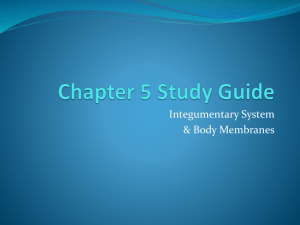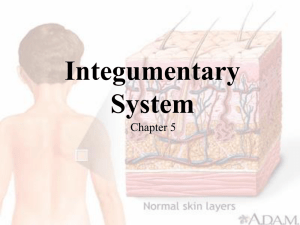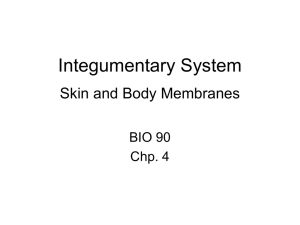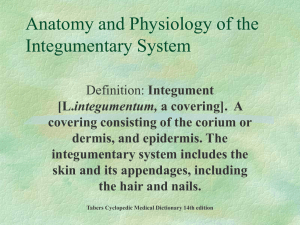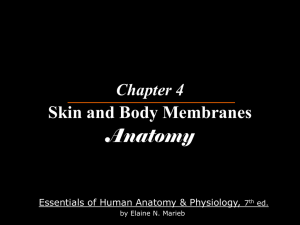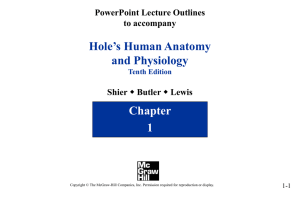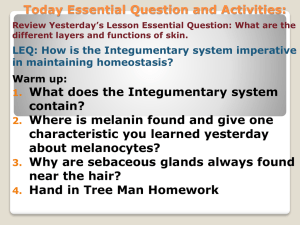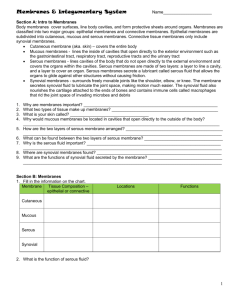Chapter 5 Study Guide
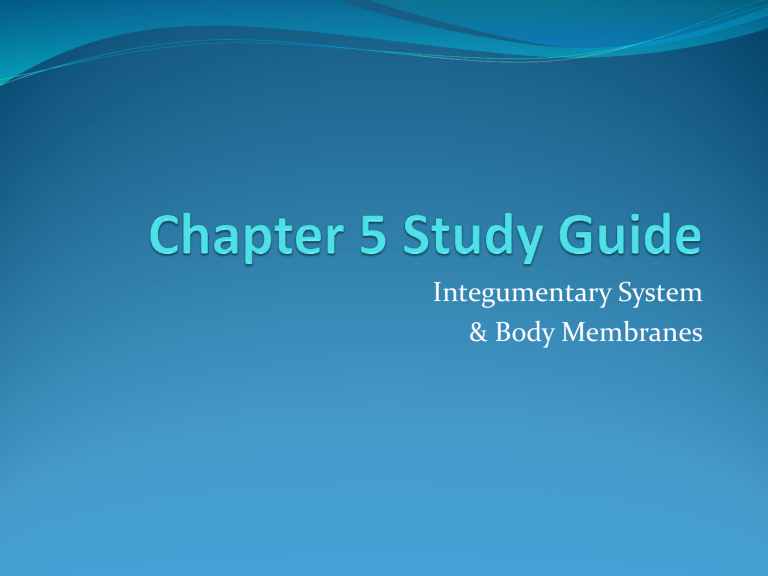
Integumentary System
& Body Membranes
3.
4.
5.
2.
1.
Chapter Objectives:
Classify, compare the structure of and give examples of each type of body membrane
Describe the structure and function of the epidermis and dermis
List and briefly describe each accessory organ of the skin
List and discuss the three primary functions of the integumentary system
Classify burns and describe how to estimate the extent of a burn injury
Classification of Body Membranes
Epithelial Membranes
:
Composed of epithelial tissue & underlying specialized connective tissue
1.Cutaneous
…aka skin
2.Serous
… aka saliva
3.Mucous
… aka snot :P
Connective Tissue Membranes:
Contain no epithelial component
1.Synovial
…line joint spaces between bones & bursae (sacs between moving body parts)
→smooth, thick
→secrete synovial fluid = for lubrication & reduce friction in joints
Serous Membranes…
Composition:
1. Thin layer of simple squamous epithelium
2. Thin layer of connective tissue -forms supportive basement membrane
Function:
1.
body cavity lining and organ surface covering
(single membrane w/ it’s surfaces named separately)
* Parietal = name for body cavity lining
* Visceral = name for serous membrane covering organs
2. Produce watery fluid to reduce friction & lubricate any organ contact
Examples:
1.
2.
Thoracic cavity= called Pleura
-so..Visceral Pleura=serous membranes covering the organs in thoracic cavity
-Pleurisy= inflamed Pleura; very painful friction of lungs rubbing chest wall
Abdominal cavity= called Peritoneum
-Peritonitis=inflamed serous membranes in abdominal cavity
Mucous Membranes…
Location:
-line body surfaces opening directly to the exterior
-respiratory, digestive, urinary & reproductive tracts
Composition:
* epithelium varies with location & function
Esophagus: stratified squamous epithelium –to protect from rough particles
-Lower Digestive Tract: simple columnar epithelium
Function:
-produce thick, slimy material- aka mucus (provide moisture)
Mucocutaneous Junction =
-skin and mucous membranes meet (eyelids, nasal opening)
lacks accessory glands, need mucous glands for moisture
-common points of infection
The Skin
*Primary organ of Integumentary System & largest body organ*
Structure:
→ Epidermis
→ Dermis
→ Subcutaneous
Appendages:
→ Hair
→ Receptors
→ Nails
→ Skin Glands
-Sudoriferous gland (sweat)
-Sebaceous gland (oil)
Function:
→ Protection
→ Temperature Regulation
→ Sense organ activity
Burns:
→Surface area estimation
→Classification
Structure: Epidermis
… outtermost layer
*Stratified Squamous Epithelium*
Tightly Packed
Arranged in layers {strata}
• Stratum Germinativum•
[innermost]
→ reproduces itself *self-repairing fxn!
→new cells move toward surface as they specialize with…
Keratin [ replaces cells cytoplasm]= tough, waterproof material for protection
• Stratum Corneum•
[outer layer of epidermis]
→ keratin filled, dead cells flake off
*Melanocytes deep in epidermisproduce melanin
→ absorb harmful UV & give skin darker pigment
→ with less melanin color can change w/ blood flow or oxygen level changes
Cyanosis: skin bluish gray with ↓blood O2 or ↓blood flow
* Specialized Junctions hold epidermis together and attach to dermis
Dermal-epidermal Junction= between thin epidermal layer and dermal layer below
Blisters: result of weakened or destroyed junctions
Structure:
Dermis
*Thicker layer
*mostly connective tissue
-cells scattered with fibers between
Upper Region:
-Dermal Papillae -parallel rows of bumps (important in junction)
-make finger/footprints unique
Deeper Dermis:
-Dense network of interlacing fibers
-Specialized nerve network for sensory info
Subcutaneous [aka. Hypodermis]
-Layer of fat
→ insulation , provide stored energy, gives protection & shock absorption
Appendages
Hair
Follicles: required for growth
Lanugo =hair of newborn
Hair Papilla: where hair growth begins base of follicle
Arrector Pili: small smooth involuntary muscle contraction makes goose bumps (ex. in cold/ or fear )
Appendages
Receptors
Appendages
Nails
-
-produced by cells of epidermis
Appendages
Skin Glands
*Sudoriferous gland (sweat)
1. Eccrine:
Most numerous produce sweat
2. Apocrine
Larger
(growth starts at pupberty)
Thicker secretions
*Sebaceous gland (oil)
-
Lubrication for hair and skin
Secretions increase during adolescence w/ hormone changes
Secretions decrease late adulthood –forming wrinkles and cracks in skin
Function
1.
Protection
“First line of defense”
Keratin
prevents movement across skin barrier, keeps bacteria out and keeps fluid in
Melanin
protects from UV
2.
Temperature Regulation
Sweat
Evaporation principle heat loss mechanism
3.
Sense Organ Activity
Touch, pressure, pain & hot/cold
Burns
“Rule of Nines”
Divides body into 11 areas-each 9%
Recovery depends on total area involved and severity
Classification of Burns
1 st Degree (sunburn)
Minor discomfort, some reddening of skin, no blistering
2 nd Degree
Severe pain, deep epidermal layers & upper dermis injured, blisters, swelling, fluid loss, scaring common
3 rd degree
(full thickness burn)
Complete destruction of epidermis and dermis, tissue death into subcutaneous tissue (can go to muscle or even bone), pain insensitive-nerve endings injured, serious fluid loss & risk of infection
